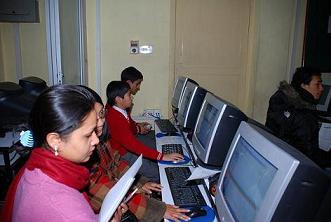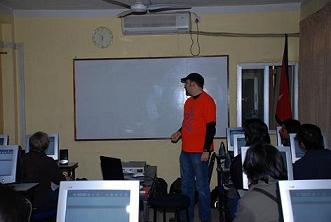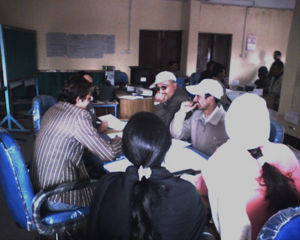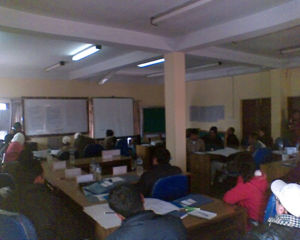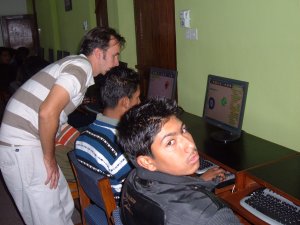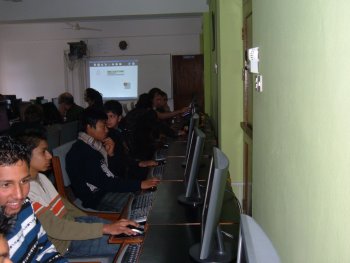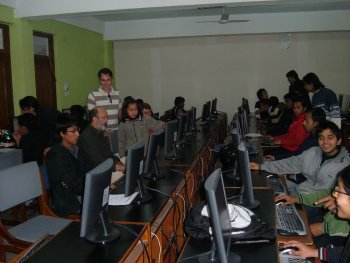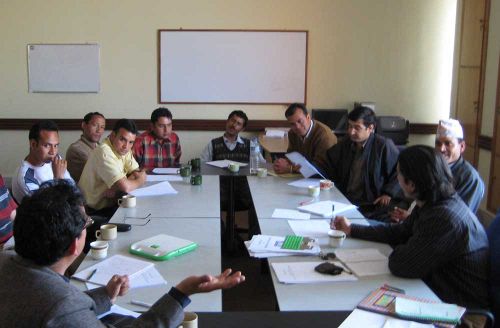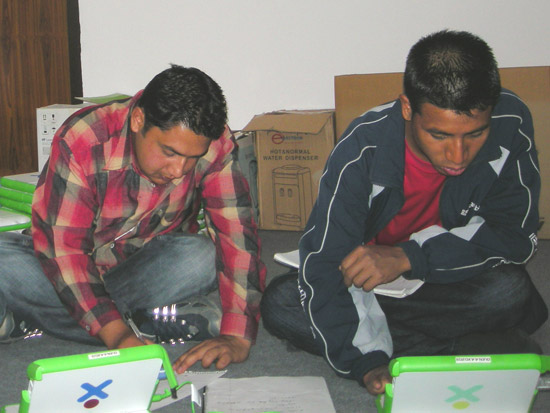OLE Nepal: Blog News
← Development · Blog Home · Testing→
News and Events
OLPC Game Jam
OLPC Game Jam
December 15th, 2007 By: Om Yadav
The first OLPC Game Jam went really well. The participant turnout was really good, all of them managed to complete the tasks we had prepared and those who were really fast were happy to find other interesting stuffs to keep them occupied.
At the end of the day most of the participants were asking us when the next ‘game jam’ was going to be held. That was the best complement we got
OLPC Game Jam
OLPC Game Jam
December 16th, 2007 By: Sulochan Acharya
The fist OLPC game jam was successfully held yesterday Dec 15th 2007, at Prime College in Kathmandu. The purpose of the game jam was mainly to familiarize students, teachers and enthusiasts with squeak, its history, and how it is used to develop various applications–such as the activities developed by OLE Nepal. The event was intended to be a fun learning session rather than a programming lesson, and I can gladly say that participants enjoyed the event. About 25 people attended the event but the most interesting and an important part that made this game jam a success was diversity. There were students of different grades, teachers with various background, the extremely talented OLE development team and expert like Bert Freudenberg who talked briefly about the history of squeak and Etoys, and showed some intriguing demos that set the tone for the day.
The event was divided into three parts:
1. Introduction (about OLPC and OLE-Nepal, squeak how-to, its interface and using squeak in general).
2. Scripting and Advance scripting in squeak.
3. Exercises and Interaction
There where practice sessions and breaks in between to give everyone a chance to work with squeak, explore its features, and ask questions and interact with the team.
The whole game jam was based on a simple car game that participants had to make during the course of the day, and the simplicity with they could use features in squeak to do something like this kept everyone glued to their screen. Many even took initiative to do more; some participants were trying to control the car that they just got running with keystrokes rather than using the mouse, and another participant was trying to reduce the speed of the car once its strays away from the track that it should be running on, adding a more authentic feel to this simple game that he just made. At the end of the day everyone seems to want to learn more.
What did we learn from this game jam?
A lot …I will list a few: 1. Everyone, especially the younger bunch was very receptive to new ideas. Many had questions, about the program, the XO, what the laptop can do, about squeak and much more.
2. Once they got the hang of using the application, they wanted more detailed (about scripting in squeak) examples.
3. Many wanted to know how they could improve themselves and what after that.
4. We provided a copy of squeak, our activities, and materials used in the workshop on a CD-ROM to each participant, and few took extra copies for their friends. This shows that a larger group of students might be interested in such events.
I also want to add that we intend to host a Game Jam every month for the next few months. We plan to have competitions during the jam where the winner will be decided by a panel of teachers, kids and government officials.
Speech to the OLPC Learning Club of DC — with video
Speech to the OLPC Learning Club of DC — with video
December 22nd, 2007 By: admin
Just last week we had Bert Freudenberg in Kathmandu and last night I met w/ some more Deutsch-speakers. Who would think the German-speaking countries and Nepal would be some of the first movers on OLPC?I especially want to thank Wayan Vota of OLPCNews for organizing the meetup and putting me in touch with Christoph and Aaron.
Here is the text of the speech for anyone who is interested in reading it, and a link to the video.
I am really happy to see so many people here are excited about the One Laptop Per Child Project. In fact, at this point it is fair to say that OLPC has graduated from being a “Project” to an international “Movement.”
For just a few minutes, please humor me and play along. Imagine that you have decided that OLPC is an incredibly exciting and important initiative, so important that you actually move to an impoverished country to implement it. Or, you might move to an impoverished region of a developed country.
Once there, you form an OLPC Learning Group with some locals that are just as excited about OLPC as you are. This group successfully lobbies the government to conduct a pilot of OLPC. Your team actually gets some laptops and you test them with kids. Things are going great. You are living the OLPC fantasy. Cheap laptops, mesh networks, and constructionist education are going to save the world. Then you slam into harsh reality, Specifically you run into the three difficult issues.
- 1: There is hardly any content for the XO. I used to think that giving a child a laptop would turn her instantly into a constructing, expressing, analyzing superstar. Well, that has not been the case from my experiences so far. Kids like working w/ the laptop but kids often get bored after about 90 minutes w/ the laptop, some after 10. There is a real shortage of basic activities for learning basic numeracy and language skills.
- 2: Teachers don’t have time for the XO. Teachers everywhere are busy, whether in Kathmandu, Washington D.C., or Vienna. Keeping up with the national curriculum leaves very little time for special projects. Further, parents and school administrators are loathe to spend time on anything that doesn’t help their kids do well on national examinations. As it stands, all the existing activities on the XO are outside of the national curriculum and thus fall outside regular schoolwork and grade-level examinations.
- 3: You have to prove it works! You absolutely, positively have to quantitatively prove to policy makers that OLPC improves the overall quality of education. There is no getting around this. You can convince politicians to approve a pilot but you will not convince policymakers and the general public to make integrate OLPC into the larger education system until you can show that OLPC makes a significant improvement in kids’ educations.
I have just walked you through what has essentially been my experience working on OLPC in Nepal over the last eighteen months. In the little bit of time I have I will tell you how we are dealing with these three issues in Nepal.Before I do that, let me tell you a little bit about myself and the Open Learning Exchange Nepal. I was a career member of the US Foreign Service for 5 years, serving in the Middle East and China, before quitting this last September to work full-time on OLPC. I helped start the OLPC movement in Nepal when I arrived in Nepal in September 2006 and I co-founded the Nepali NGO Open Learning Exchange Nepal. Open Learning Exchange Nepal is working with the government of Nepal to implement the OLPC pilot there. I would love to talk later w/ anyone who is interested in learning more about our pilot strategy and implementation plan.
Enough about me, let’s get back to those three killer problems.
- 1 : There isn’t enough content
- 2 : Teachers aren’t going to use XO’s if the laptops don’t help them do their existing work better.
- 3 : We have to prove that laptops actually improve learning.
Here is how we are trying to create a lot of high-quality content, quickly. We are using the tool Squeak, the same platform that Etoys uses. With Squeak, we can develop a learning activity within a few days and literally modify a learning activity on the fly without having to recompile. Additionally, Etoys is cross platform. It is absolutely essential that people who don’t have XO’s can develop and test our activities.
We call our methodology “Educator-Driven Development” (Blog post to come on this subject) because we have two seasoned educators on our team that drive the development process. They sketch out learning activities, critique and revise learning activities created by others, and analyze how kids and teachers react to our learning activities. The team develops learning activities in several day long to week-long iterations. We test the activities with kids on weekly basis. Our educators know both Nepal’s national curriculum and more importantly how kids learn. By and large, programmers don’t know how kids learn. Great Teachers know how kids learn. We really see in this how programmers consistently overestimate the difficulty of teaching advanced skills and underestimate the difficulty of teaching basic skills.
Because Squeak is a graphical drag-and-drop environment we can develop learning activities quickly and non-programmers such as educators and graphic designers can manipulate the elements within a learning activity. There is only one tool besides Squeak that offers this functionality, Adobe’s flexbuilder. We are using Squeak because we feel it is inherently more powerful than Flex.
We have avoided developing learning activities using PyGTK because PyGTK applications are not particularly portable and Python code is just not “discoverable” like the graphical scripting environment in Etoys or Flex. I do not foresee non-programmers hacking Python code written by others. I can and have seen non-programmers modifying fairly sophisticated Etoys, such as the ones we have developed in Nepal.
Alright, on to problem #2: Teachers are busy. They are not going to use the XO unless it helps them do their jobs as specified by the existing curriculum. To manage this, we are aligning all of our learning activities with the national curriculum and for the first year we are focusing on the two subjects that Nepali students struggle the most with: Mathematics and English.
Not to be forgotten, we have to train teachers how to integrate laptops into education. This training has three dimensions:
1. How to use computers in general
2. Learn the principles behind child-centered/constructionist/experiential learning
3. How to use computers for child-centered learning.
Now to PolicyMakers: We have to show them some statistical improvement in the quality of education. This comes right back to content. By focussing on the subjects that students have the most difficulty with, we think we can show significant improvement within a short period of time.
Now I can talk almost indefinitely about the various aspects of OLPC and what we are doing Nepal. I will take your questions now and be happy to speak with you individually. Thanks for your time and thanks to Wayan Vota of OLPCNews for organizing this event.
Interaction program with teachers
Interaction program with teachers
January 22nd, 2008 By: Sulochan Acharya
On January 14, 2008, OLE Nepal organized a day-long interaction program with teachers at the National Center for Education Development (NCED), the government body responsible for training public school teachers all over the country. The program was organized in coordination with the Department of Education. The goal of the program was to inform teachers about the development of digital educational material and its implementation through the OLPC program, as well as to gather teachers’ perspective of the OLPC program and the use of digital content to enhance the teaching-learning process. After a short presentation by Rabi Karmacharya, and Dr. Saurav Dev Bhatta about the objectives of the projects, the remaining workshop was carried out on an interactive manner.
The program was attended by 25 public school teachers from 12 public schools from Kathmandu, Lalitpur, Bhanktapur, Kavre, and Surkhet. Deputy Director from NCED Mr. Gorakh Bahadur Singh gave the keynote speech. Four subject specialists from Curriculum Development Center (CDC) were also present to give their views on the development of curriculum based digital content. Nepal Teacher’s Union was represented by one of its central members.
The teachers formed smaller discussion groups to discuss the challenges in implementing the OLPC project in the classroom level. Each group then presented the their views on how to effectively use the laptops in daily teaching, and the types of training and support the teachers would need before and during the project. about OLE Nepal intends to use the suggestions gathered in this interaction program to prepare a teacher training package in cooperation with the NCED.
Second OLPC Game Jam
Second OLPC Game Jam
January 30th, 2008 By:Om Yadav · No Comments
Please see this posting in full on the Announcements page.
Get your car to squeak: Second OLPC Game Jam
Get your car to squeak: Second OLPC Game Jam
February 9th, 2008 By: Sulochan Acharya
Today Ace Institute of Management hosted the second OLPC game jam organized by OLE Nepal. Students and enthusiasts from various schools got a chance to learn the basics of Squeak to create simple applications. Participants were shown how to make a simple car game. Each participants had to get a car moving, with a steering wheel
controlling its motion. A simple script would then give it a more authentic game feel by making the car move faster on the track and decelerate when it strayed out of the track.
Members from OLPC and OLPC Nepal were present at the the event.
Among other things students were encouraged to communicate and collaborate with each other through the Squeak Community Forum. They were also encouraged to make their own activities and post it on the forum. The development team at OLE Nepal will help the forum participants by giving suggestions and by guiding them through problems that they might face using squeak.
More pictures and information to follow in the next post.
Four Villages One Goal: ICT4D
Four Villages One Goal: ICT4D
March 4th, 2008 By: Sulochan Acharya
I just came back from a six day trip to four villages in Kaski district. These villages are in the mountainous region outside Pokhara. My mission was to add educational resources like school wikipedia, e-books, and the learning activities, among other things, to the schools in these villages, and to show students and teachers how to use and utilize them to enhance learning. In the process I leaned a lot about what information technology means for these villages, and how it is being used for education and development.
A little information about these villages and schools:
Village name: Chandrakot
School : Sangam Secondary school
Number of students (approx): 300
Number of teachers: 12
Number of computers: 5
Village Name: Magh Jaun
School : Tanchok Primary School
Number of students (approx): 150
Number of teachers: 6
Number of computers: 2
Village Name: Bhichuk
School: Bhichuk Primary School
Number of students (approx): 100
Number of computers: 2
Village Name: Tolka
School : Himalaya Secondary School
Number of students (approx): 400
Number of teachers: 12
Number of computers: 2
All four schools have internet access, and are connected to each other and to a larger network of many other villages through the efforts of the Nepal Wireless project. So what does it really mean for these schools to have computers, and internet? “It means that our kids wont be like us,” says Heetman, a teacher at Himalayan Secondary School in Tolka. “I had only heard about computers until we got one a while back.” Its not about a bigger change. For the villagers it is more about being able to do smaller thing, like reading todays news online, and being able to type a letter. However, we should not expect any positive outcome in education in these schools because of these computers. As a matter of fact, most of the students i talked to complained that, they do not get to use the computers too often. Why? I asked the people in-charge. “We do not have enough people to who know computers to conduct classes,” they said.
What is striking is that the villagers agree that these computers, and the VoIP service will gear them towards development. The value of the technology is understood, at least in parts, that they believe that it is concomitant to development. “We want the information and communication technology to make a positive impact on the village.” But is it? My focus were school kids, the next generation of villagers who would actually be able to make any impact in the village, and sadly young generation here are still far behind when it comes to using technology. Its not all gloomy though. It is already amazing that these villages have internet and VoIP services. It is only a matter of time before they can really start using it for development. All four villages do have the right idea; use information and communication technology for development.
Interaction Program with Dept of Education
Interaction Program between Dept of Education, OLE Nepal, and pilot school teachers
March 14th, 2008 By: Rabi Karmacharya
We had a meeting yesterday at the Department of Education with teachers from the two pilot schools, officials from the Department of Education, and OLE Nepal. The meeting was also attended by an official from District Education Office where the pilot is being launched. Seven teachers and administrators from Bashuki School and Biswamitra School pledged their support and cooperation, and ensured full participation from all stakeholders including school administration, and school management committee. They were visibly pleased that the Department had picked their schools to pilot the project.
During the meeting, we briefed them about the project and our plan to use the schools as models when we expand the project to more schools and districts later this year. They understood that their roles were vital in the long term success of OLPC in Nepal. We had long discussions about the preparations that need to take place between now and the launch in mid-April. Few teachers put forth their concerns about safety and security of equipments, adequate teacher preparation, networking, etc. We informed them that there will be an extensive teacher preparation program including 4 days of residential training, followed by 3 days of onsite training. We decided that the residential training should take place from March 29 till April 1. After the residential training, the teachers will return to their school communities where they will hold interaction programs with parents and communities to make them aware of the OLPC project. During the interaction, they will discuss the roles of the parents, and answer questions from the communities. We thought that it is best to have teachers interact with the communities and educate them about the program, with minimal interventions from our organization.
The Department of Education and District Education Office reiterated their full support for the program, and expressed their interest in using the lessons learned during this first phase in the larger implementation of the project in the future.
About our teacher preparation program
About our teacher preparation program
April 4th, 2008 By: Saurav Dev Bhatta
We at Sajha Sikchya E-Paati (OLE Nepal) firmly believe that one of the most important steps in implementing any ICT-based educational approach is teacher preparation. Unless the teachers are fully comfortable with this new approach to teaching, providing students with computers and educational content alone will have limited impact on the teaching learning process.
Basic structure of the training
Driven by the above belief, we have designed a teacher training package that aims to empower teachers to integrate ICT-based educational materials in the teaching-learning process so that they can independently design and implement lesson plans incorporating ICT-based materials.
The taining consists of two major segments: a) a 4 day intensive residential, out-of-school training that focuses on giving the teachers hands on experience in integrating digitial educationals materials and ICT-based teaching approaches in the regular classroom instruction process and b) a 3 day training in the teachers’ regular classrooms where they get to implement the integrated lesson plans they developed during the 4 day residential training.
As the second segment starts at the beginning of the school year, there a gap between the two segments. During this gap, the teachers play with the computers on their own and become even more familiar with the laptop and the avaialbe digitial educational materials. Then, a couple of days before the 3-day in-class training, the teachers themselves organize and lead interaction programs with parents/guardians and other stakeholders in their communities to introduce this new concept and generate commnity support. Since teachers are highly respected members of the local community, they are far more capable of garnering community support for this new idea than outside “experts”.
We completed our 4-day intensive residential training on April 1, 2008. The second segment—in-class training—will take place in the third week of April.
Content covered in the training
Effective teacher preparation in ICT-based education requires adequate training in three areas:
1) Information technology literacy
2) Child-centric interactive teaching
3) Integration of ICT-based instruction in child-centric interactive teaching.
This training covered all three areas. However, it must be emphasized that integration of ICT-based instruction in child-centric interactive teaching was the focus of this training.
The specific content covered in the training included the following:
- 1. Using the XO: introduction to the different components of the XO according to the most frequent tasks the user would have to perform. Main goal: help participants overcome their fear of computers and technology.
- 2. Classroom arrangement/management: arrangement of the classroom furniture to maximize XO protection and maximize interaction (both between students and betweenstudents and teachers); formulating classroom rules and job lists.
- 3. Education theory: Piaget’s theory of cognitive development, Vigotsky’s theory on scaffholding, Papert’s ephasis on interactive learning; experiment’s to illustrate some of these theories.
- 4. Overview of digital content avaialble: E-paati interactive actictivities and e-library.
- 5. Exercises with E-Paati interactive activities: how these activities enable students to learn new concepts, provide practice exercises, and give opportuties for self-evaluation while emphizing the “fun” element in learning.
- 6. Exercises with the OLE electronic library: exploration of the different sections of this full-text library and introduction to how the user can browse the library sections, search for specific items, and read books on the XO.
- 7. Model lesson: demostration of a full grade 2 class period to show how E-paati activities can be integrated into the regular classroom teaching-learning process (included non-computer pre-activities, E-patti interactive activits, and post-activities).
- 8. Practice teaching: volunteers among the trainees designed and conducted a full class that fully integrated E-paati interactive activities.
- 9. Making integrated lesson plans: participants worked in pairs to design lesson plans integrating E-paati activties in their regular classes.
- 10. Planning for interaction sessions with parents/guardians and other stakeholders in the community
Participants in the training
There were a total of 27 participants, including teachers, government officials, and members of the school management committee of the two schools—Bashuki Lower Secondary School and Bishwamitra Ganesh Lower Secondary School.
Total teachers from Biswamitra: 11
Total teachers from Bashuki: 10
Staff involved in the training
Trainers: Bipul Gautam (co-ordinator and lead trainer), Saurav Dev Bhatta, and Kamana Regmi.
Engineers/System admins: Bryan Berry and Sulochan Acharya
Supporters behind the scene: Rabi Karmacharya, Rajeev Adhikari, and Upaya Sharma.
Venue: Malip International School, Panauti (around 35 km from Kathmandu)—thanks to Malpi principal and Sajha Sikchya E-Paati Board Member Mr. Jyoti Man Sherchan.
Day-by –day activities: brief overview
Length of typical training day: 8:30 am to 6:00pm; plus pot-dinner activities (homework + optional activities)
Day 0 (March 28): arrival at Malpi International School; training room setup; introductions
Day 1 (March 29): official inaguration ceremony, discussion of participants’ expectations, overview of the OLPC pilot project being launched by OLE Nepal and Department of Education, using the XO (focus of Day 1) , overview of digitial content available, exercises with E-Paati activities.
Day 2 (March 30): quiz, classroom arrangement/management, education theory (Piaget), model lesson, more practice with E-Paati activities
Day 3 (March 31): quiz, education theory (Vigotsky), introduction to E-library, lesson planning, more exercises with E-Paati activities, video of a government school using child-centric teaching-learning approach, disassembling the computer and putting it back together.
Day 4 (April 1): quiz, practice teaching, planning for interactions with parents/guardians and other stakeholders, feedback.
Most interesting outcomes
- Even teachers with absolutely no familiary with computers became very comfortable with the machine within 3 hours!
- Most participants had to be ushered out of the training hall at 10pm against their will. Some of them wanted to continue till midnight.
- Their enthusiasm and interest went beyond our wildest expectations.
- Two of the teachers (Manoj and Neema) were able to completely disassemble and reassemble the XOs within 3 hours.
- The most effective way of teaching the participants how to use the XO was through peer interaction.
- The teachers themselves developed new and appropriate vocabulary for certain specific functions of the computer.
- Once it was clear that the machine would not replace them, they were much more receptive—and they easily picked up the concept of integrating ICT-based educational materials in their daily classroom instruction process. The practice teaching session (conducted by Bashuki teacher Neema and Biswamitra teacher Bhim) was simply superb!
- The teachers were able to figure out new uses of the interactive E-Paati activites—uses we had not thought of before—on their own.
- The pace of learning was similar for both older and younger teachers—older teachers were not slower (contrary to expectations).
- Lady teachers were quicker learners.
- When the participants were using the XOs, the most effective way (or perhaps the only effective way) to turn their attention towards the trainer was by asking them to close the XO. This is a technique they will have to use regularly in their own classrooms if they want their students to pay attention to what they are saying.
My experience with OLE-nepal
My experience with OLE-nepal
April 8th, 2008 By: Manoj
Hello World,
I am Manoj Ghimire from Bishwamitra Ganesh Lower Secondary School. I have been working in this school for last two years. I teach maths and science for the lower secondary level.
I am also an ex-student of this school. When the school upgraded from primary level to the lower secondary level, they needed extra teachers but there wasn’t any source to pay for the teachers. I worked as a volunteer for a year since, it is my school and my community. From last year onwards,I am working as a fulltime teacher.
We are glad to be selected as the pilot school for the ‘One Laptop Per Child’ programme.
Last month, we had a four day Teachers’ Preparation Training. The training was organized and conducted by OLE-Nepal. OLE-Nepal is the partner of Government of Nepal to implement the programme to the government schools. The theme of the training was to instruct the teachers how to use the E-Paati (Nepali name of xo laptop) in our traditional method of teaching. Since, most of our teachers hadn’t used the computers so far. So, it was totally a new thing to use the E-paati. The training become very useful to us. They selected me from my school and Neema Lama from Bashuki School for the three day technical training.
I am right now at the OLE-Nepal’s office at Sanepa,Lalitpur. This is day-2 of the three day technical training. We are very excited. Yesterday, Neema and me stayed and learned together. We learned about disabling the security, changing the firmware of the E-Paati and testing the whole things. We also learned to change default locale to nepali and to install the activities. We too got some information about wireless networking.
Yesterday evening, Neema had to leave due to some election purpose. He will return on Friday.
Today,I am learning about basics of commandlines used in the Unix/Linux, which might help me solving the simple problems in the school server. I have to study about the Linux OS this week. We are also going to fix some faulty E-Paatis. Moreover, we are going to look at the school server.
Remaining: I’ll post later or after some days.
Orientation Program for Parents and Other Stakeholders
Orientation Program for Parents and Other Stakeholders
April 22nd, 2008 By: Saurav Dev Bhatta
Please see this posting in full on the Development page.
Teacher Preparation Program for the OLPC Project - Part II
Teacher Preparation Program for the OLPC Project—Part II
May 4th, 2008 By: Saurav Dev Bhatta
Please see this posting in full on the Development page.
Some interesting feedback from teachers at Bashuki
Some interesting feedback from teachers at Bashuki
May 16th, 2008 By: Saurav Dev Bhatta
Please see this posting in full on the Development page.

